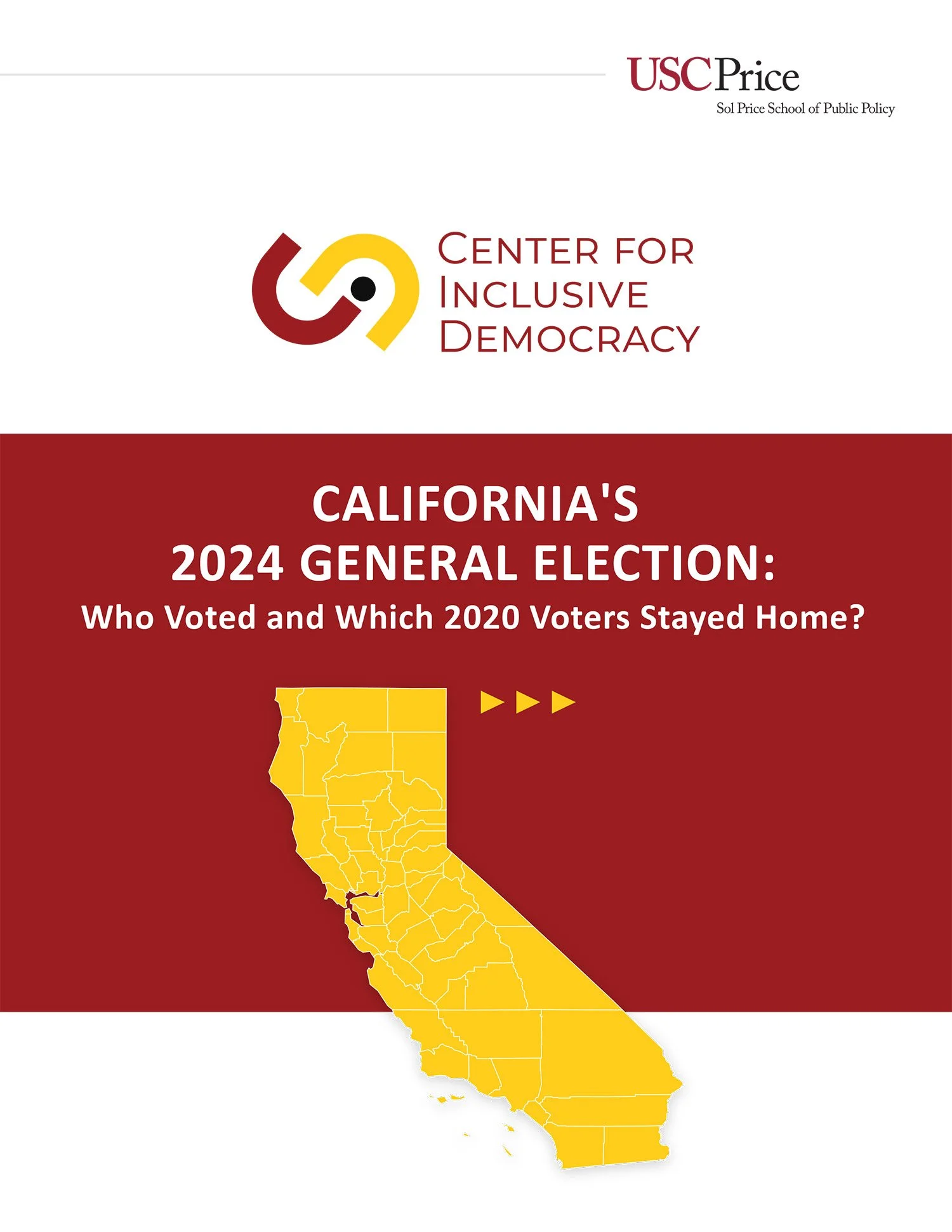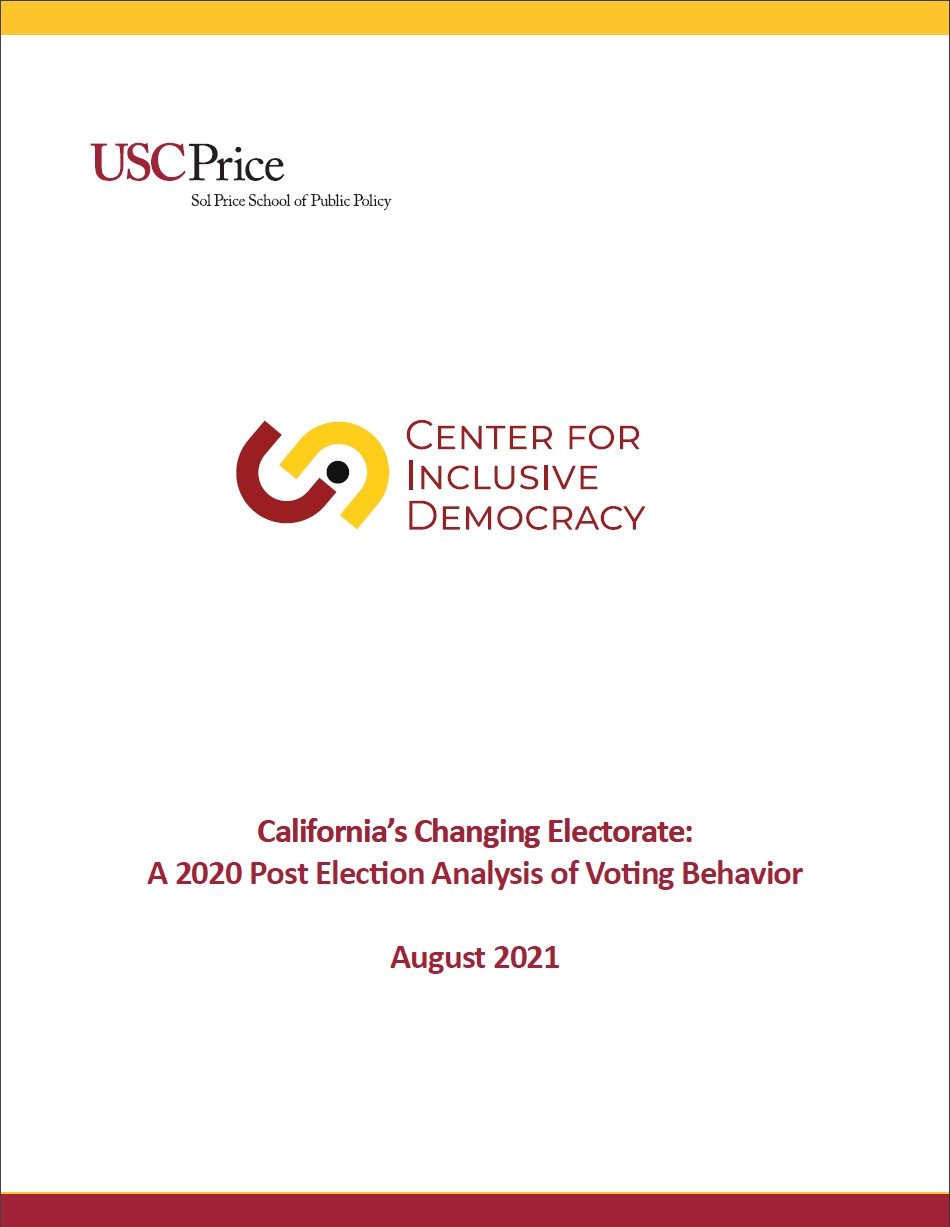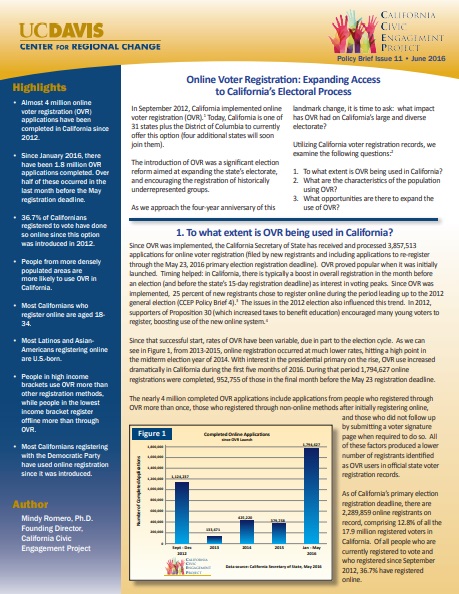CID Election Turnout Research
The use of vote-by-mail ballots in California has become increasingly common over the past decade, due to expanded voting options in the state. After a steady increase in the share of votes being cast via vote-by-mail ballots, the 2020 general election saw a notable jump in use due in large part to the COVID-19 pandemic and the state’s decision to send every registered voter a ballot. To ensure a safe election, California sent every registered voter a vote-by-mail ballot in the 2020 general election, a policy that was later made permanent in Fall 2021. Voting method trends seen in 2020 continued into the 2022 midterm election cycle in an environment less restricted by COVID-19.
With the expansion of vote-by-mail access made permanent and COVID-19 becoming less of a consideration for many voters on how and when to vote, many policy makers and voter advocates are questioning whether the voting behaviors in the 2020 and 2022 general elections such as the widespread use of vote-by-mail ballots—will continue in future elections at the same level. To address this speculation, CID conducted a statewide analysis of voter behavior in the 2024 general election. In this report, we examine voting methods and vote by- mail ballot rejections in the 2024 general election broken out by race, ethnicity, age group, party affiliation, gender and language designation.
Click here for report.
Click here for the highlights brief.
Click here for the full video of the report webinar.
Click here for the highlights of the report webinar.
CALIFORNIA'S 2024 GENERAL ELECTION:
Who Voted and Which 2020 Voters Stayed Home?
New Release!
After historically high turnout in the 2020 presidential election amidst the COVID-19 pandemic, the 2024 presidential election saw a decline in turnout across California. Despite the hopeful expectations of many that the voter behavior seen in 2020 would become the new normal, a notable number of Californians who participated four years earlier did not participate in November. This drop in turnout prompted many policymakers, advocates and researchers to ask who participated in the 2024 presidential election, and possibly more importantly, who did not. To explore these questions, the Center for Inclusive Democracy conducted a statewide analysis of voter participation in the 2024 presidential election by examining official California voter files. Analysis was broken out by race, ethnicity, age group, party affiliation, gender and language designation.
Click here for report.
Click here for the highlights brief.
Click here for the press release.
Click here for the full video of the report webinar.
Click here for the highlights of the report webinar.
CALIFORNIA’S CHANGING ELECTORATE: An examination of shifting party demographics in California presidential elections
new release!
California has been known as the largest state Democratic stronghold in the nation for decades, with no Republican candidate winning the state’s coveted electoral college votes since 1988. In the 2024 presidential election, however, just under 59% of Californians voted for the Democratic nominee, Vice President Kamala Harris, resulting in the state’s smallest Democratic vote share in a presidential general election since 2004. A similar story of decline and a corresponding increase in the vote share of Republicans was seen in many jurisdictions across the country, prompting much speculation as to why this occurred and whether it will endure in future elections, especially among young voters and voters of color.
With a focus on California, this brief provides a better understanding of the increased Republican vote share in the state’s 2024 general election by placing the results within a greater historical context. We examine the changing official party registration of California’s registered voters between the presidential elections of 2008 and 2024, while also breaking out the degree of change by race, ethnicity, age and their intersections.
Click here for the report.
The New Electorate: The Strength of the Latino, Black and Asian-American Vote
Women of Color Vote
CID presents new research on the voting power of women of color in the U.S. The brief analyzes differences in voter turnout by gender in the U.S., nationally and by congressional district, revealing geographic hot spots where Black and Asian-American women, along with Latinas have the potential for an even greater impact on the upcoming election.
This research brief is the fourth in a series by CID on the strength of the Latino, Asian-American and Black Vote in the U.S.
Click here for the report.
The New Electorate: The Strength of the Latino, Black and Asian-American Vote
COMPETITIVE CONGRESSIONAL DISTRICTS IN THE 2024 ELECTION CYCLE
The Center for Inclusive Democracy at the USC Price School of Public Policy releases a new research report analyzing voter turnout in the 43 competitive U.S. congressional districts. The report found that in most of these districts, the number of eligible Asian-American, Black and Latino voters who did not vote in 2022 was greater than the margin of victory in many of those districts’ House races—and often by a significant amount.
Click here for the congressional district report.
Click here for the press release.
Click here for other reports in this series examining turnout in battleground states and at the national level.
Vote-by-Mail Ballot Tracking: A Multi-State Analysis of Voter Turnout and Rejection Rates
In response to the 2020 COVID-19 pandemic, vote-by-mail ballots were used by an unprecedented number of voters in the presidential election. In the same year, some states introduced or expanded the availability of a vote-by-mail ballot tracking tool to their voters. Two years after this expansion, the 2022 midterm election cycle continued to see large shares of voters in these states using vote-by-mail ballots. This report examines ballot tracking use in the 2022 general election in three states that adopted the tool - California, Colorado, and Georgia – to better understand who is using the tool, their preferences, and how their voting behaviors differ from those who don’t use the tool.
Click here for the report.
Click here for the report appendix.
Click here for the press release for this report.
The Voter Turnout in California: Challenges and Opportunities for Mobilization
Using recently updated citizen voting-age population estimates based on the 2020 Decennial Census, a new California voter turnout report from the Center for Inclusive Democracy at the USC Price School of Public Policy has found that more than 40% of Asian-American and Latino eligible California voters—an estimated 5.4 million—did not vote in the 2020 general election. In 2022, that percentage rose to 60%, equating to 8.6 million eligible Asian-American and Latino voters who did not cast a ballot, signaling a significant opportunity to mobilize these population groups and narrow turnout gaps come November.
The Voter Turnout in California: Challenges and Opportunities for Mobilization report also examined shifts in the racial composition of California's eligible voter population (adult citizens) based on new estimates for 2020 and 2022. Particularly noticeable shifts included the decrease in the share of white, non-Latino voters and the concurrent increase in the share of Asian-American and Latino eligible voters. The share of eligible voter that were white, non-Latino dropped three percentage points between the old and new 2020 eligible voter population estimates, while Asian-American voters’ share rose from 12.7% to 14.5%, and Latinos 30.4% to 32.7%.
Even with the increase of eligible Latino and Asian-American voters in 2020 to 2022, however, the CID analysis confirmed a continued and persistent “voter representation gap” for the 2020 and 2022 general elections. The voter representation gap is a phenomenon in which voters of color remain underrepresented at the polls, despite their substantial population growth.
Click here for the report
Click here for the two page highlights brief
CID Research Series: The New Electorate - The Strength of the Latino, Black, and Asian-American Vote
Battleground State Research Briefs
Arizona, Florida, Georgia, Michigan, North Carolina, Nevada, Pennsylvania, Wisconsin, and Texas
CID’s new battleground state research briefs provide an up-to-date profile of Latino, Asian-American, and Black voting power in swing states and highly contested states. These briefs examine the changing demographic landscape in each state, the participation of Latino, Asian-American, and Black eligible voters in general elections, and identifies the potential electoral influence voters of color could have on national and local elections. The study also includes a breakdown of the role that voters of color will play in the 2024 elections.
Click here for all nine state briefs
Click here for the press release
NATIONAL REPORT
Earlier this year, CID issued a national report on voter turnout. The New Electorate: The Strength of the Latino, Black and Asian-American Vote report revealed that in the 2020 presidential election, Asian-American, Black, and Latino eligible voters comprised nearly 30% of those eligible to vote in the U.S., but represented just over 22% of all votes cast, significantly lower than their share of eligible voters. The report found this entrenched voter representation gap evident across nearly all U.S. elections.
Future reports in this series will include an analysis of the impact and opportunity of the Latino, Black and Asian-American vote in 2024 competitive congressional districts.
Click here to download the national report
Click here to download the two-page brief of the national study's highlights
Voting Methods in California: Voter Awareness and Reasons for Disparate Use
Currently, the overwhelming majority of Californians vote by returning their vote-by-mail ballot through the mail or by dropping off their ballot at a drop off box. However, use of voting options in the state varies by demographic group, including voting in-person, with Latinos and young voters using polling places and vote centers at higher rates than the general voting population.
Understanding the differential experiences that California voters have with available methods for casting ballots is essential to the development of effective public voter outreach and education strategies developed to increase participation in the state’s elections, including the upcoming November 2024 general election. To this aim, the USC Center for Inclusive Democracy (CID) conducted a statewide representative survey of eligible voters in California examining the information they have about their voting options, the reasons voters use a particular voting method in casting their ballot, and their voting preferences for the future.
Click here for the full report
Click here for the four-page highlight brief
Click here for report's appendix
Click here for the webinar recording and presentation slides
Voting Methods in California: Disparate Use and Rejection Rates
The ways in which Californians cast their votes has been changing over the past decade. In the 2020 general election, the first in which every registered voter in California automatically received a vote-by-mail ballot, vote-by-mail voting surged to over 87% of all votes cast. CID conducted a statewide analysis of voting methods in the 2022 general elections in order to understand if the voting behaviors seen in the 2020 general election amid the COVID-19 pandemic continued in the state.
Click here for the full report
Click here for the four-page highlight brief
Click here for report's appendix
Click here for the webinar recording and presentation slides
VOTER MESSAGING IN CALIFORNIA: CHALLENGES AND OPPORTUNITIES IN AN INEQUITABLE ELECTION LANDSCAPE
Understanding the barriers to voting that many Californians experience is essential to the development of effective public voter outreach and education strategies aimed at increasing participation in the state’s elections, including the November 2024 general election.
To inform the efforts of election officials, community groups, and others working to develop these strategies, this webinar presents new CID research findings on barriers to casting a ballot by California eligible voters, their knowledge and awareness of voting information, as well as the impact of different types of voting-related messages on their likelihood of casting a ballot.
Click here for full report
Click here for the three-page highlight brief
Click here for report's appendix
Click here for the webinar recording and presentation slides
CALIFORNIA'S BALLOT TRACKING SERVICE: WHO IS USING IT AND HOW DOES IT IMPACT VOTER CONFIDENCE AND BEHAVIOR?
Statewide ballot tracking was introduced to California voters in the 2020 election cycle. Available in all 58 counties, the BallotTrax tool sends updates via email, text, or voice message informing
registrants when their vote-by-mail ballot has been mailed to them, when it has been received by their county elections office, and the status of their ballot as it is processed.
This new report from the USC Center for Inclusive Democracy examines who signed up for BallotTrax to track their vote-by-mail ballot, what their voting behaviors are, and what their preferences are when signed up for BallotTrax . Findings improve the understanding of how BallotTrax may be influencing Californians’ interactions with the electoral process.
Click here for report's appendix
Click here for the two-page highlight brief
Click here for the webinar recording and presentation slides
The New Electorate - The Strength of the Latino, Black and Asian-American Vote
CID’s new research report provides an up-to-date profile of Latino, Asian-American and Black voting power throughout the United States. Despite notable growth in the eligible voter population, voters of color have historically been underrepresented in the electorate, creating a substantial voter participation gap.
This report examines the changing demographic landscape in each state, the participation of Latino, Asian-American and Black eligible voters in general elections, and identifies the potential electoral influence voters of color could have on national and local elections. The study also includes a breakdown of the role that voters of color will play in the 2024 elections.
Future reports in this series will include an analysis of the impact and opportunity of the Latino, Black and Asian-American vote in 2024 swing states and competitive congressional districts.
Click here to download the report
Click here to download the two-page brief of study highlights
Voter Turnout in California's Redrawn Congressional Districts
California’s Formerly Incarcerated: Challenges and Opportunities in Accessing Voting Rights
the experience of black voters in california: 2020 general election and beyond
2020 Primary Election - Voter Outreach and Education in Counties Adopting the California Voter’s Choice Act
2020 General Election Voter Outreach and Education in Counties Adopting the California Voter’s Choice Act
Voter Registration in California 2020 General Election
Click here for the full report
Click here for report’s online appendices of data charts and tables







































